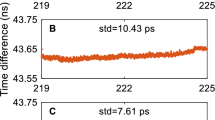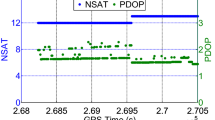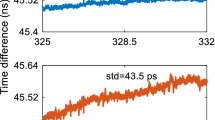Abstract
The linear combinations of multi-frequency carrier-phase measurements for Global Navigation Satellite System (GNSS) are greatly beneficial to improving the performance of ambiguity resolution (AR), cycle slip correction as well as precise positioning. In this contribution, the existing definitions of the carrier-phase linear combination are reviewed and the integer property of the resulting ambiguity of the phase linear combinations is examined. The general analytical method for solving the optimal integer linear combinations for all triple-frequency GNSS is presented. Three refined triple-frequency integer combinations solely determined by the frequency values are introduced, which are the ionosphere-free (IF) combination that the Sum of its integer coefficients equal to 0 (IFS0), the geometry-free (GF) combination that the Sum of its integer coefficients equal to 0 (GFS0) and the geometry-free and ionosphere-free (GFIF) combination. Besides, the optimal GF, IF, extra-wide lane and ionosphere-reduced integer combinations for GPS and BDS are solved exhaustively by the presented method. Their potential applications in cycle slip detection, AR as well as precise positioning are discussed. At last, a more straightforward GF and IF AR scheme than the existing method is presented based on the GFIF integer combination.


Similar content being viewed by others
References
Blewitt G (1989) Carrier phase ambiguity resolution for the global positioning system applied to geodetic baselines up to 2000 km. J Geophys Res 94:10187–10203
Blewitt G (1990) An automatic editing algorithm for GPS data. Geophys Res Lett 17(3):199–202
Bonillo-Martínez C, Toledo-López M, Romay-Merino M (1999) The benefits of the GPS three frequencies on the ambiguity resolution techniques. ION GPS 99, 14–17 September 1999, Nashville, TN, pp 1737–1746
Cocard M, Bourgon S, Kamali O, Collins P (2008) A systematic investigation of optimal carrier-phase combinations for modernized triple-frequency GPS. J Geod 82(9):555–564
Cocard M, Geiger A (1992) Systematic search for all possible wide-lanes. In: Proceedings of the 6th International Geodetic Symposium on Satellite Positioning, Columbus Ohio March 17–20, 1992, pp 312–318
Collins JP (1999) An overview of GPS inter-frequency carrier phase combinations. Unpublished paper. http://gauss.gge.unb.ca/papers.pdf/L1L2combinations.collins.pdf
Dong D, Bock Y (1989) Global positioning system network analysis with phase ambiguity resolution applied to crustal deformation studies in California. J Geophys Res 94:3949–3966
Feng Y (2008) GNSS three carrier ambiguity resolution using ionosphere-reduced virtual signals. J Geod 82(12):847–862
Forssell B, Martin-Neira M, Harrisz RA (1997) Carrier phase ambiguity resolution in GNSS-2. In: Proceedings of the ION GPS-97, 16–19 September. Kansas City, MO, pp 1727–1736
Han S (1995) Theory and applications of the combinations of GPS dual-frequency carrier phase observations. Acta Geodaetica et Cartographica Sinica 24(2):8–13
Han S, Rizos C (1996) Improving the computational efficiency of the ambiguity function algorithm. J Geod 70(6):330–341
Han S, Rizos C (1999) The impact of two additional civilian GPS frequencies on ambiguity resolution strategies. In: Proceedings of ION 55th Annual Meeting, Alexandria VA, January 25–27, 1999, pp 315–321
Hatch R, Jung J, Enge P, Pervan B (2000) Civilian GPS: the benefits of the three frequencies. GPS Solut 3(4):1–9
Hatch R (2006) A new three-frequency, geometry-free, technique for ambiguity resolution. In: Proceeding ION GNSS, Ft Worth, TX, USA, 26–29 Sept 2006, pp 309–316
Henkel P (2009) Geometry-free linear combinations for Galileo. Acta Astronaut 65:1487–1499
Jung J, Enge P, Pervan B (2000) Optimization of cascade integer resolution with three civil GPS frequencies. In: Proceedings of the ION GPS-2000. Institute of Navigation, Salt Lake City, UT, pp 2191–2200
Li B, Feng Y, Shen Y (2010) Three carrier ambiguity resolution: distance-independent performance demonstrated using semi-generated triple frequency GPS signals. GPS Solut 14(2):177–184
Li J (2011) Researches on the algorithms of GNSS triple frequency precise positioning (in Chinese). Information Engineering University, Zhengzhou
Li J, Yang Y, He H, Xu J, Guo H (2012a) Optimal carrier-phase combinations for triple-frequency GNSS derived from an analytical method (in Chinese). Acta Geod Cartogr Sin 41(6):797–803
Li J, Yang Y, Xu J, He H, Guo H (2012) Ionosphere-free combinations for triple-frequency GNSS with application in rapid ambiguity resolution over medium-long baselines. In: Proc China Sat Nav Conf (CSNC) 2012:173–187
Li J (2014) BDS/GPS multi-frequency real-time precise positioning theory and algorithms (in Chinese). Information Engineering University, Zhengzhou
Odijk D (2003) Ionosphere-free phase combinations for modernized GPS. J Surv Eng 129(4):165–173
Richert T, El-Sheimy N (2007) Optimal linear combinations of triple-frequency carrier phase data from future global navigation satellite systems. GPS Solut 11(1):11–19
Seeber G (2003) Satellite Geodesy, 2nd completely revised and extended edn. Walter de Gruyter, Berlin
Simsky A (2006) Three’s the charm: triple-frequency combinations in future GNSS. Inside GNSS july/august 2006, pp 38–41
Teunissen PJG (1995) The least-squares ambiguity decorrelation adjustment: a method for fast GPS integer ambiguity estimation. J Geod 70(1):65–82
Urquhart L (2009) An analysis of multi-frequency carrier phase linear combinations for GNSS. Senior technical report, Department of Geodesy and Geomatics Engineering Technical Report No. 263, University of New Brunswick, Fredericton, New Brunswick, Canada, 71 pp
Wang K, Rothacher M (2013) Ambiguity resolution for triple-frequency geometry-free and ionosphere-free combination tested with real data. J Geod 87(6):539–553
Zhang X, He X (2015) BDS triple-frequency carrier-phase linear combination models and their characteristics. Sci China Earth Sci 58(6):896–905
Acknowledgments
This work is supported by the National Natural Science Funds of China (Grant Nos. 41374019; 41020144004; 41474015) and the National “863 Program” of China (Grant No: 2013AA122501).
Author information
Authors and Affiliations
Corresponding author
Rights and permissions
About this article
Cite this article
Li, J., Yang, Y., He, H. et al. An analytical study on the carrier-phase linear combinations for triple-frequency GNSS. J Geod 91, 151–166 (2017). https://doi.org/10.1007/s00190-016-0945-2
Received:
Accepted:
Published:
Issue Date:
DOI: https://doi.org/10.1007/s00190-016-0945-2




